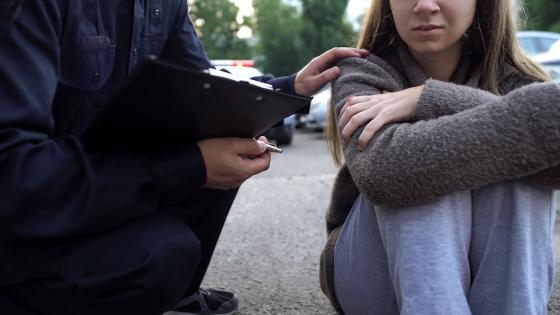Given the large costs of crime to society (Bindler and Ketel 2022), there is substantial policy interest in identifying effective crime prevention strategies. Many studies have focused on the effects of increasing the size of the police force (Chalfin and McCrary 2018, Chalfin et al. 2021, Mello 2019) and implementing tougher sanctions (Bell et al. 2014, Katz, et al. 2003) on criminal activity. However, as budget-constrained cities across the country face increasing calls to allocate the marginal crime-prevention dollar away from law enforcement and toward social programmes, there is growing interest in early policy interventions that prevent the development of offenders in the first place, such as high-quality childcare (Garcia et al. 2017), access to mental healthcare (Deza et al. 2020, Jacome 2020), cognitive behavioural therapy (Heller et al. 2017), and lead remediation (Billings and Schnepel 2018, Gronqvist, et al. 2020).
One solution that policymakers frequently suggest is to better fund public schools. Yet, there is little causal evidence linking increases in school funding to reductions in crime. Most studies evaluating the impacts of school spending have focused on outcomes such as test scores, educational attainment, wages, and intergenerational mobility (Lafortune et al. 2018, Jackson et al. 2016, Hyman 2017, Baron 2022, Biasi forthcoming). In a recent paper, we ask whether it is possible to reduce adult crime by increasing public school funding (Baron et al. 2022).
We isolate the causal effect of increased spending on adult criminal activity by leveraging a change in school finance in Michigan due to the state’s 1994 school finance reform, known as Proposal A. Like many states around the country, in the 1980s and early 1990s, Michigan financed K-12 public education primarily through local property taxes. Due to growing spending inequalities across school districts, as well as rapidly increasing property tax burdens, Michigan voters approved Proposal A in 1994. The reform centralised financing at the state level and assigned each district a per-pupil allotment for ‘operating’ expenditures (e.g. the salaries of teachers and support staff). The state gave larger increases to school districts with lower school expenditures prior to the reform, with the goal of equalising spending over time. We compare the outcomes of elementary school students who experienced larger spending increases to the outcomes of children attending elementary schools in districts and years that received little or no increases in funding.
We use a novel dataset that links K-12 public school and higher education records from the Michigan Department of Education, the Center for Educational Performance and Information, and the National Student Clearinghouse to adult criminal justice records from the Michigan State Police. Our dataset consists of nearly 1.2 million students who were first-time kindergarteners in Michigan public schools between the 1994-95 and 2003-04 academic years.
Our work yields several key findings:
- Students exposed to 10% greater school funding each year from kindergarten through grade 3 experienced a two percentage point (15%) reduction in the likelihood of being arrested in adulthood (ages 17-30).
One criticism of the school spending literature has been that, while the analyses provide solid evidence that money matters, it is somewhat of a ‘black box’ in terms of how and why greater spending translates to improved outcomes. An advantage of the Michigan context over other settings is the richness of our data, which allow us to investigate plausible mechanisms.
- We rule out the explanation that the crime-reducing effect is driven by positive peer effects from changing peer composition.
While it is possible that wealthier families in districts that received no additional funding could move to districts that received additional spending to take advantage of the school quality improvements, we find little evidence that this is the case. A likely explanation for this finding is that districts that received additional funding in our setting were primarily located in rural areas. Unlike in urban and suburban areas, these school districts are geographically large and spread out, meaning that families in districts that received no funding increases would have to move long distances to reap the benefit of the spending increases.
- Students who attended better funded schools were taught by teachers with greater experience and earning higher salaries, were in smaller class sizes, and attended schools with a larger number of administrators such as vice-principals.
While we find no evidence of changes in peer composition, we show that additional school funding impacted key indicators of school quality. We find that 10% greater spending during grades K-3 led to teachers earning roughly $4,000 (5%) higher salaries and with two additional years (13%) of experience, a 4% smaller student-teacher ratio, and a 12% smaller student-administration ratio, where administration includes superintendents, assistant superintendents, principals, and vice-principals.
- A likely reason for the observed reduction in adult arrests is that students in better funded schools had better academic and behavioural outcomes, and higher educational attainment.
We find that students exposed to 10% greater funding in grades K-3 were 8 percentage points (50%) less likely to be chronically absent in 8th grade (defined as missing over 10% of school days during the academic year), were 3 percentage points (4%) more likely to graduate high school, and 2 percentage points (6%) more likely to graduate from college.
Contrary to what we might expect, the improvements in cognitive outcomes (e.g. high school and college graduation) explain a modest share of the overall crime-reducing effect (roughly 20%). Instead, we find that improvements in proxies for non-cognitive outcomes or ‘soft skills’ (e.g. daily school attendance rates and chronic absenteeism) explain a much larger share of the overall effect (roughly 40%). These findings are consistent with prior studies showing that additional years of schooling reduce crime (Hjalmarsson et al. 2015, Lochner and Moretti 2004, Machin et al. 2011, Meghir et al. 2012), but also show that previous knowledge of how school funding impacts cognitive outcomes does not accurately predict how increasing spending will impact adult crime.
Is this approach cost effective?
A natural question that arises from our work is whether increased school spending is cost effective with respect to investments in other social programmes or law enforcement personnel. We follow the work of Hendren and Sprung-Keyser (2020) and estimate that, for every government dollar to increase public school funding, the associated reduction in crime generates roughly $2 in social benefits. In other words, we find that increases in school quality (due to increases in school funding) pay for themselves even considering only the associated crime reductions and ignoring all other potential benefits such as increases in educational attainment and earnings. We also show that the cost-effectiveness of school funding at preventing crime is similar to other early childhood education interventions such as Head Start and the Perry Preschool Project, and to increasing the number of sworn police officers.
What about capital spending?
Although school inputs such as class size and teacher compensation are crucial dimensions of school quality, the physical condition of school infrastructure is another important input. Public expenditures on school facilities in the US totalled roughly $80 billion in 2015 and make up approximately 13% of all K-12 public school spending. Given the importance of school facility spending, we evaluate the causal impact of increased capital spending using a second feature of Michigan’s school finance system: close bond elections. While Proposal A caused dramatic changes in operating expenditures, it left decisions regarding the level of capital spending up to school districts via local bond elections. Districts where elections pass are likely to systematically differ from those that lose (e.g. having stronger preferences for education spending). Thus, we compare districts that narrowly pass a capital bond election to those that narrowly lose because these districts are likely to be very similar yet receive drastically different amounts of capital spending.
We find that narrowly passing a bond referendum leads to an immediate increase of $2,000 per pupil in capital outlays (~200%), which dissipates after two to three years. We subsequently find that kindergarteners in such districts, who are exposed to these additional capital expenditures during elementary school, are 2.7 percentage points (or 20%) less likely to be arrested in adulthood. Exploring mechanisms, we find little evidence that capital investments improved cognitive outcomes, but we do observe large increases in attendance and declines in chronic absenteeism. These findings highlight two important points: first, even in the absence of cognitive improvements, capital investments can yield other important social benefits; second, increases in operating and capital spending can each reduce crime.
Conclusion
We evaluate the long-run effects of improvements in school quality due to increases in school spending on adult criminal activity – a social problem which imposes enormous costs on society each year. We find that students exposed to additional school spending, either operating or capital, in early elementary grades experience substantial reductions in the probability of being arrested as adults. Our results show that improving public schools can keep children on a path of increased school engagement and completion, thereby lowering their criminal propensity in adulthood.
References
Baron, E J (2022), “School Spending and Student Outcomes: Evidence from Revenue Limit Elections in Wisconsin”, American Economic Journal: Economic Policy 14(1): 1–39.
Baron, E J, J Hyman and B N Vasquez (2022), “Public School Funding, School Quality, and Adult Crime”, NBER Working Paper 29855.
Bayer, P, R Hjalmarsson and D Pozen (2009), “Building Criminal Capital Behind Bars: Peer Effects in Juvenile Corrections”, The Quarterly Journal of Economics 124(1): 105–147.
Bell, B, L Jaitman and S Machin (2014), “Crime Deterrence: Evidence from the London 2011 Riots”, The Economic Journal 124(576): 480–506.
Biasi, B (forthcoming), “School Finance Equalization Increases Intergenerational Mobility: Evidence From a Simulated Instruments Approach”, Journal of Labor Economics.
Billings, S B, D J Deming and S L Ross (2019), “Partners in Crime”, American Economic Journal: Applied Economics 11(1): 126–50.
Billings, S B and K T Schnepel (2018), “Life after lead: Effects of early interventions for children exposed to lead”, American Economic Journal: Applied Economics 10(3): 315–44.
Bindler A and N Ketel (2022), “The far-reaching consequences of becoming a victim of crime”, VoxEU.org, 6 February.
Chalfin, A and J McCrary (2018), “Are U.S. Cities Underpoliced? Theory and Evidence”, Review of Economics and Statistics 100(1): 167–186.
Chalfin, A, B Hansen, E K Weisburst and M C Williams (2021), “Police Force Size and Civilian Race”, American Economic Review: Insights forthcoming.
Deza, M, C Maclean and K Solomon (2020), “Local access to mental healthcare and crime”, VoxEU.org, 14 November.
Garcia, J L, J Heckman, D E Leaf and M Prados (2017), “The long-term benefits of quality early childcare for disadvantaged mothers and their children”, VoxEU.org, 25 August.
Grönqvist, H, J P Nilsson and P-O Robling (2020), “Understanding how Low Levels of Early Lead Exposure Affect Children’s Life Trajectories”, Journal of Political Economy 128(9): 3376–3433.
Heller, S, A Shah, J Guryan, J Ludwig, S Mullainathan and H Pollack (2017), “Thinking Fast and Slow? Some Field Experiments to Reduce Crime and Dropout in Chicago”, The Quarterly Journal of Economics 132(1): 1–54.
Hendren, N and B Sprung-Keyser (2020), “A Unified Welfare Analysis of Government Policies”, The Quarterly Journal of Economics 135(3): 1209–1318.
Hjalmarsson, R, H Holmlund and M J Lindquist (2015), “The effect of education on criminal convictions and incarceration: Causal evidence from micro-data”, The Economic Journal 125(587): 1290-1326.
Hyman, J (2017), “Does Money Matter in the Long Run? Effects of School Spending on Educational Attainment”, American Economic Journal: Economic Policy 9(4): 256–80.
Jackson, C K, R C Johnson and C Persico (2016), “The Effects of School Spending on Educational and Economic Outcomes: Evidence from School Finance Reforms”, The Quarterly Journal of Economics 131(1): 157–218.
Jácome, E (2020), “Mental Health and Criminal Involvement: Evidence from Losing Medicaid Eligibility”, Working paper.
Katz, L, S D Levitt and E Shustorovich (2003), “Prison Conditions, Capital Punishment, and Deterrence”, American Law and Economics Review 5(2): 318–343.
Lafortune, J, J Rothstein and D W Schanzenbach (2018), “School Finance Reform and the Distribution of Student Achievement”, American Economic Journal: Applied Economics 10(2): 1–26.
Lochner, L and E Moretti (2004), “The effect of education on crime: Evidence from prison inmates, arrests, and self-reports”, American Economic Review 94(1): 155-189.
Machin, S, O Marie and S Vujic (2011), “The crime reducing effect of education”, The Economic Journal 121(552): 463-484.
Meghir, C, M Palme and M Schnabel (2012), “The effect of education policy on crime: an intergenerational perspective”, NBER Working Paper 18145.
Mello, S (2019), “More COPS, Less Crime”, Journal of Public Economics 172: 174–200.






